A Report on Contemporary Issues and Interprofessional Practice (PP610)
VerifiedAdded on 2022/12/30
|11
|3825
|1
Report
AI Summary
This report delves into the realm of interprofessional practice (IPP) within healthcare, emphasizing the significance of collaborative teamwork and effective communication among healthcare professionals. The report begins with a personal scenario illustrating IPP dynamics and potential ethical concerns, such as the handling of sensitive patient procedures. It then defines IPP, highlighting its benefits in improving healthcare quality and efficiency through shared goals and mutual respect among team members. Core values such as patient-centered care, accountability, and adherence to ethical standards are discussed, along with relevant legislation and professional standards. The report identifies current issues impacting the workplace, including unprofessional behaviors, organizational barriers, and deficiencies in training and team dynamics. It concludes by exploring the impact of these barriers on patient care and offering insights into how to improve teamwork and address challenges in the healthcare environment.

Contemporary Issues and
Interprofessional Practice
Code: PP610
Interprofessional Practice
Code: PP610
Paraphrase This Document
Need a fresh take? Get an instant paraphrase of this document with our AI Paraphraser
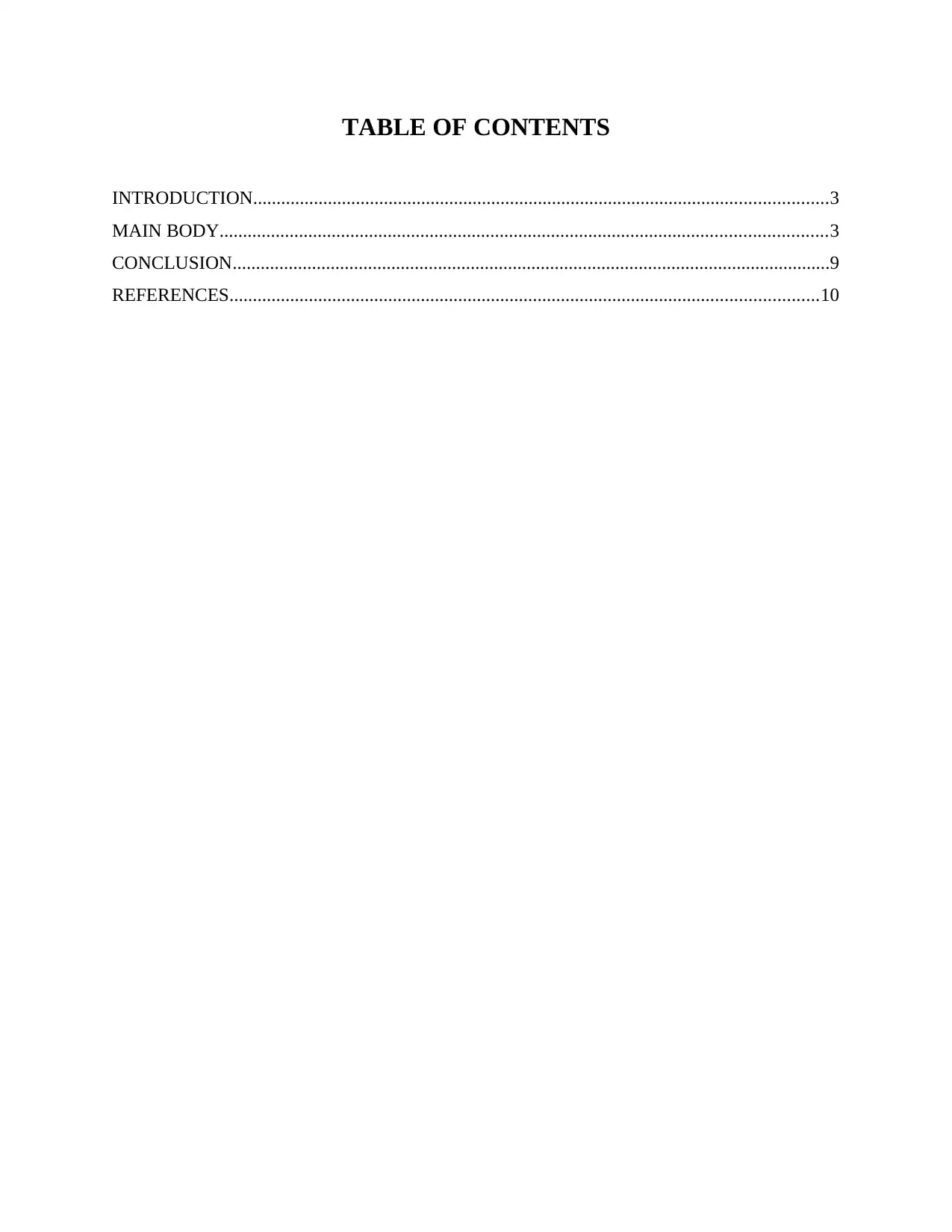
TABLE OF CONTENTS
INTRODUCTION...........................................................................................................................3
MAIN BODY..................................................................................................................................3
CONCLUSION................................................................................................................................9
REFERENCES..............................................................................................................................10
INTRODUCTION...........................................................................................................................3
MAIN BODY..................................................................................................................................3
CONCLUSION................................................................................................................................9
REFERENCES..............................................................................................................................10

INTRODUCTION
The entire healthcare system is established on the basis of accountability, quality of care
and collaboration of teams in professional settings. Collaborative practice is directly associated
with improvement in health care delivery. This report is based on interprofessional practice
where the models, systems and principles for working effectively and collaboratively with other
professional at a different hierarchical level, i.e., nurse practitioner will be elaborated. There will
be development of concept of skills, values, knowledge and attributes that are needed in the
interprofessional practices of self and others. The report will be developing a systematic
conceptualisation and understanding of the contemporary literature pertaining to IPP and policy
based and legal framework. The report will also highlight a reflective understanding of the
reasons of health and social care failures, the meaning to service users and the best practices.
MAIN BODY
Brief of the scenario
I have experienced interprofessional collaboration and working with a professional from
another department and hierarchical level, i.e., practice nurse, when working as a care assistant.
In the inception of my job, the manager asked the nurse regarding a display of the technique to
change the stoma bag of a client. The nurse was extremely experienced, kind, polite and
professional and explained the whole procedure of this treatment to be with clear and distinct
steps. But this led me to a confused state as she conducted the procedure in front of everyone in
the lounge. This came as a shock to me because according to my learning and knowledge, the
procedure had to be done in a private space or the room of the service user. As I was a new
joinee at that time, I chose to speak about or clarify the matter. I did that out of the respect for
hierarchical position and job role of the nurse, and so I refrained from any confrontation. But on
a later realization, I feel that the action conducted by the nurse was incorrect and unethical in
terms of professionalism and needs to be discussed.
Interprofessional practice
Interprofessional practice and care can be defined as a collaborative practice that happens
when the heath care workers work along with the people from their own profession, along with
people outside the profession and also with the families and patients. In my case, I worked in
interprofessional context with the practice nurse, with the clients a and patient’s families, other
3
The entire healthcare system is established on the basis of accountability, quality of care
and collaboration of teams in professional settings. Collaborative practice is directly associated
with improvement in health care delivery. This report is based on interprofessional practice
where the models, systems and principles for working effectively and collaboratively with other
professional at a different hierarchical level, i.e., nurse practitioner will be elaborated. There will
be development of concept of skills, values, knowledge and attributes that are needed in the
interprofessional practices of self and others. The report will be developing a systematic
conceptualisation and understanding of the contemporary literature pertaining to IPP and policy
based and legal framework. The report will also highlight a reflective understanding of the
reasons of health and social care failures, the meaning to service users and the best practices.
MAIN BODY
Brief of the scenario
I have experienced interprofessional collaboration and working with a professional from
another department and hierarchical level, i.e., practice nurse, when working as a care assistant.
In the inception of my job, the manager asked the nurse regarding a display of the technique to
change the stoma bag of a client. The nurse was extremely experienced, kind, polite and
professional and explained the whole procedure of this treatment to be with clear and distinct
steps. But this led me to a confused state as she conducted the procedure in front of everyone in
the lounge. This came as a shock to me because according to my learning and knowledge, the
procedure had to be done in a private space or the room of the service user. As I was a new
joinee at that time, I chose to speak about or clarify the matter. I did that out of the respect for
hierarchical position and job role of the nurse, and so I refrained from any confrontation. But on
a later realization, I feel that the action conducted by the nurse was incorrect and unethical in
terms of professionalism and needs to be discussed.
Interprofessional practice
Interprofessional practice and care can be defined as a collaborative practice that happens
when the heath care workers work along with the people from their own profession, along with
people outside the profession and also with the families and patients. In my case, I worked in
interprofessional context with the practice nurse, with the clients a and patient’s families, other
3
⊘ This is a preview!⊘
Do you want full access?
Subscribe today to unlock all pages.

Trusted by 1+ million students worldwide
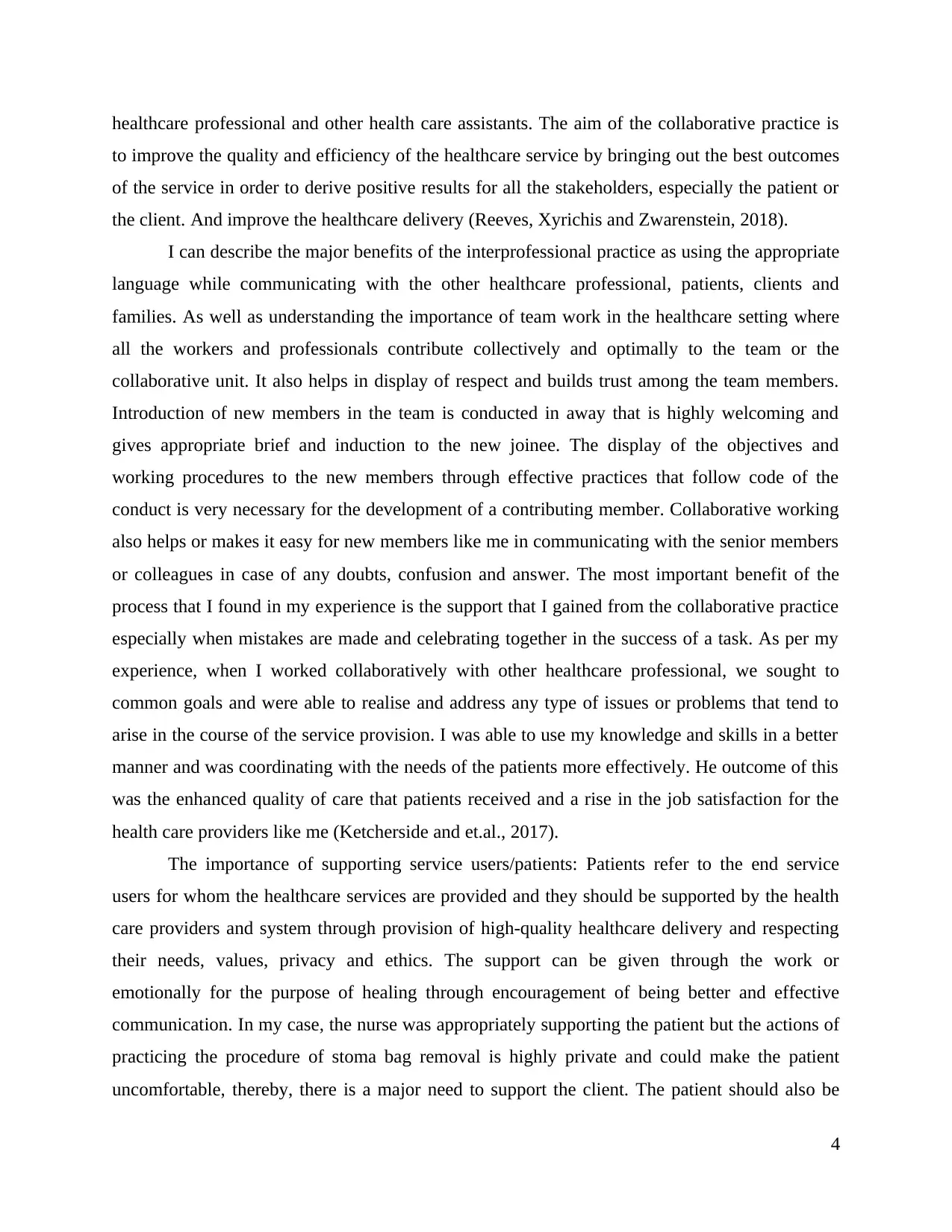
healthcare professional and other health care assistants. The aim of the collaborative practice is
to improve the quality and efficiency of the healthcare service by bringing out the best outcomes
of the service in order to derive positive results for all the stakeholders, especially the patient or
the client. And improve the healthcare delivery (Reeves, Xyrichis and Zwarenstein, 2018).
I can describe the major benefits of the interprofessional practice as using the appropriate
language while communicating with the other healthcare professional, patients, clients and
families. As well as understanding the importance of team work in the healthcare setting where
all the workers and professionals contribute collectively and optimally to the team or the
collaborative unit. It also helps in display of respect and builds trust among the team members.
Introduction of new members in the team is conducted in away that is highly welcoming and
gives appropriate brief and induction to the new joinee. The display of the objectives and
working procedures to the new members through effective practices that follow code of the
conduct is very necessary for the development of a contributing member. Collaborative working
also helps or makes it easy for new members like me in communicating with the senior members
or colleagues in case of any doubts, confusion and answer. The most important benefit of the
process that I found in my experience is the support that I gained from the collaborative practice
especially when mistakes are made and celebrating together in the success of a task. As per my
experience, when I worked collaboratively with other healthcare professional, we sought to
common goals and were able to realise and address any type of issues or problems that tend to
arise in the course of the service provision. I was able to use my knowledge and skills in a better
manner and was coordinating with the needs of the patients more effectively. He outcome of this
was the enhanced quality of care that patients received and a rise in the job satisfaction for the
health care providers like me (Ketcherside and et.al., 2017).
The importance of supporting service users/patients: Patients refer to the end service
users for whom the healthcare services are provided and they should be supported by the health
care providers and system through provision of high-quality healthcare delivery and respecting
their needs, values, privacy and ethics. The support can be given through the work or
emotionally for the purpose of healing through encouragement of being better and effective
communication. In my case, the nurse was appropriately supporting the patient but the actions of
practicing the procedure of stoma bag removal is highly private and could make the patient
uncomfortable, thereby, there is a major need to support the client. The patient should also be
4
to improve the quality and efficiency of the healthcare service by bringing out the best outcomes
of the service in order to derive positive results for all the stakeholders, especially the patient or
the client. And improve the healthcare delivery (Reeves, Xyrichis and Zwarenstein, 2018).
I can describe the major benefits of the interprofessional practice as using the appropriate
language while communicating with the other healthcare professional, patients, clients and
families. As well as understanding the importance of team work in the healthcare setting where
all the workers and professionals contribute collectively and optimally to the team or the
collaborative unit. It also helps in display of respect and builds trust among the team members.
Introduction of new members in the team is conducted in away that is highly welcoming and
gives appropriate brief and induction to the new joinee. The display of the objectives and
working procedures to the new members through effective practices that follow code of the
conduct is very necessary for the development of a contributing member. Collaborative working
also helps or makes it easy for new members like me in communicating with the senior members
or colleagues in case of any doubts, confusion and answer. The most important benefit of the
process that I found in my experience is the support that I gained from the collaborative practice
especially when mistakes are made and celebrating together in the success of a task. As per my
experience, when I worked collaboratively with other healthcare professional, we sought to
common goals and were able to realise and address any type of issues or problems that tend to
arise in the course of the service provision. I was able to use my knowledge and skills in a better
manner and was coordinating with the needs of the patients more effectively. He outcome of this
was the enhanced quality of care that patients received and a rise in the job satisfaction for the
health care providers like me (Ketcherside and et.al., 2017).
The importance of supporting service users/patients: Patients refer to the end service
users for whom the healthcare services are provided and they should be supported by the health
care providers and system through provision of high-quality healthcare delivery and respecting
their needs, values, privacy and ethics. The support can be given through the work or
emotionally for the purpose of healing through encouragement of being better and effective
communication. In my case, the nurse was appropriately supporting the patient but the actions of
practicing the procedure of stoma bag removal is highly private and could make the patient
uncomfortable, thereby, there is a major need to support the client. The patient should also be
4
Paraphrase This Document
Need a fresh take? Get an instant paraphrase of this document with our AI Paraphraser
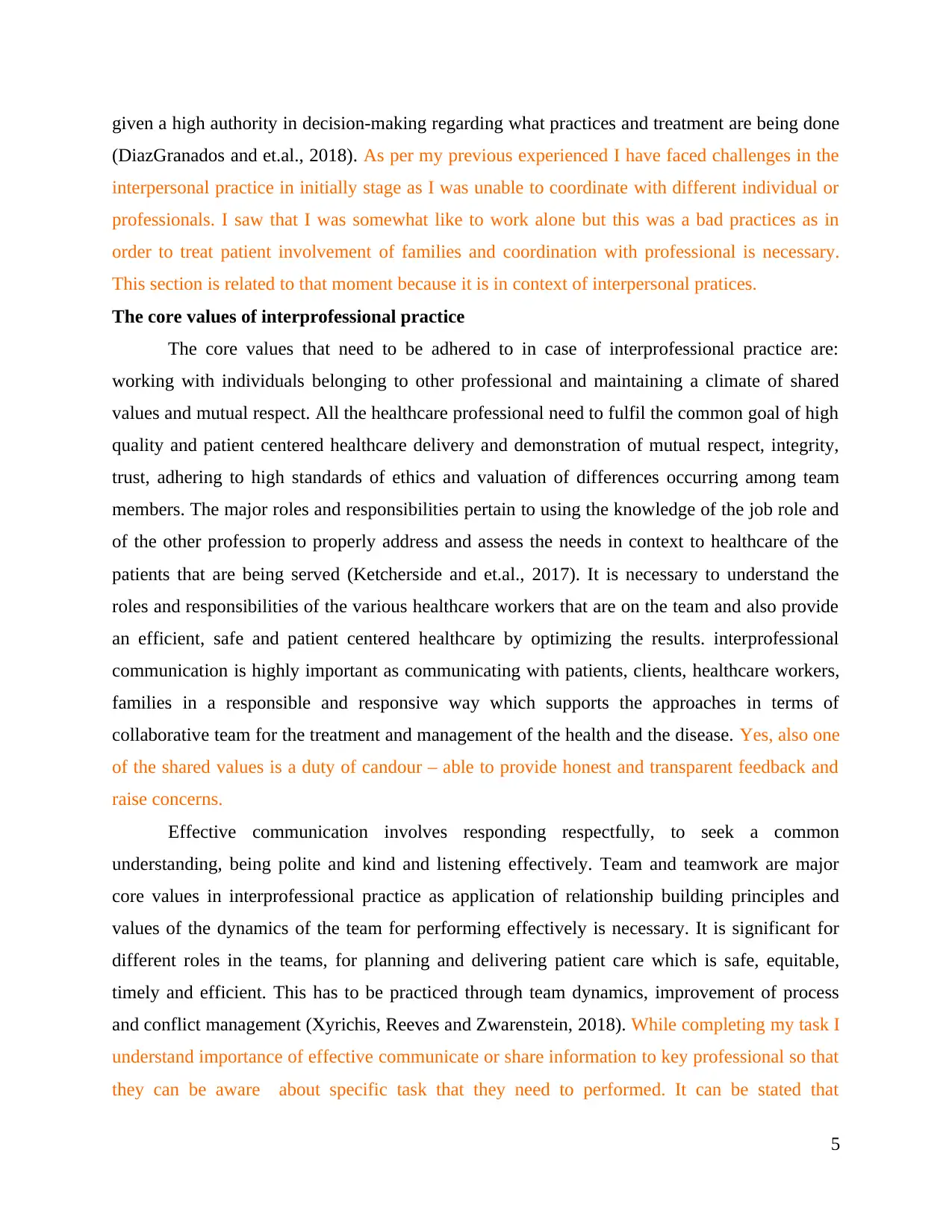
given a high authority in decision-making regarding what practices and treatment are being done
(DiazGranados and et.al., 2018). As per my previous experienced I have faced challenges in the
interpersonal practice in initially stage as I was unable to coordinate with different individual or
professionals. I saw that I was somewhat like to work alone but this was a bad practices as in
order to treat patient involvement of families and coordination with professional is necessary.
This section is related to that moment because it is in context of interpersonal pratices.
The core values of interprofessional practice
The core values that need to be adhered to in case of interprofessional practice are:
working with individuals belonging to other professional and maintaining a climate of shared
values and mutual respect. All the healthcare professional need to fulfil the common goal of high
quality and patient centered healthcare delivery and demonstration of mutual respect, integrity,
trust, adhering to high standards of ethics and valuation of differences occurring among team
members. The major roles and responsibilities pertain to using the knowledge of the job role and
of the other profession to properly address and assess the needs in context to healthcare of the
patients that are being served (Ketcherside and et.al., 2017). It is necessary to understand the
roles and responsibilities of the various healthcare workers that are on the team and also provide
an efficient, safe and patient centered healthcare by optimizing the results. interprofessional
communication is highly important as communicating with patients, clients, healthcare workers,
families in a responsible and responsive way which supports the approaches in terms of
collaborative team for the treatment and management of the health and the disease. Yes, also one
of the shared values is a duty of candour – able to provide honest and transparent feedback and
raise concerns.
Effective communication involves responding respectfully, to seek a common
understanding, being polite and kind and listening effectively. Team and teamwork are major
core values in interprofessional practice as application of relationship building principles and
values of the dynamics of the team for performing effectively is necessary. It is significant for
different roles in the teams, for planning and delivering patient care which is safe, equitable,
timely and efficient. This has to be practiced through team dynamics, improvement of process
and conflict management (Xyrichis, Reeves and Zwarenstein, 2018). While completing my task I
understand importance of effective communicate or share information to key professional so that
they can be aware about specific task that they need to performed. It can be stated that
5
(DiazGranados and et.al., 2018). As per my previous experienced I have faced challenges in the
interpersonal practice in initially stage as I was unable to coordinate with different individual or
professionals. I saw that I was somewhat like to work alone but this was a bad practices as in
order to treat patient involvement of families and coordination with professional is necessary.
This section is related to that moment because it is in context of interpersonal pratices.
The core values of interprofessional practice
The core values that need to be adhered to in case of interprofessional practice are:
working with individuals belonging to other professional and maintaining a climate of shared
values and mutual respect. All the healthcare professional need to fulfil the common goal of high
quality and patient centered healthcare delivery and demonstration of mutual respect, integrity,
trust, adhering to high standards of ethics and valuation of differences occurring among team
members. The major roles and responsibilities pertain to using the knowledge of the job role and
of the other profession to properly address and assess the needs in context to healthcare of the
patients that are being served (Ketcherside and et.al., 2017). It is necessary to understand the
roles and responsibilities of the various healthcare workers that are on the team and also provide
an efficient, safe and patient centered healthcare by optimizing the results. interprofessional
communication is highly important as communicating with patients, clients, healthcare workers,
families in a responsible and responsive way which supports the approaches in terms of
collaborative team for the treatment and management of the health and the disease. Yes, also one
of the shared values is a duty of candour – able to provide honest and transparent feedback and
raise concerns.
Effective communication involves responding respectfully, to seek a common
understanding, being polite and kind and listening effectively. Team and teamwork are major
core values in interprofessional practice as application of relationship building principles and
values of the dynamics of the team for performing effectively is necessary. It is significant for
different roles in the teams, for planning and delivering patient care which is safe, equitable,
timely and efficient. This has to be practiced through team dynamics, improvement of process
and conflict management (Xyrichis, Reeves and Zwarenstein, 2018). While completing my task I
understand importance of effective communicate or share information to key professional so that
they can be aware about specific task that they need to performed. It can be stated that
5
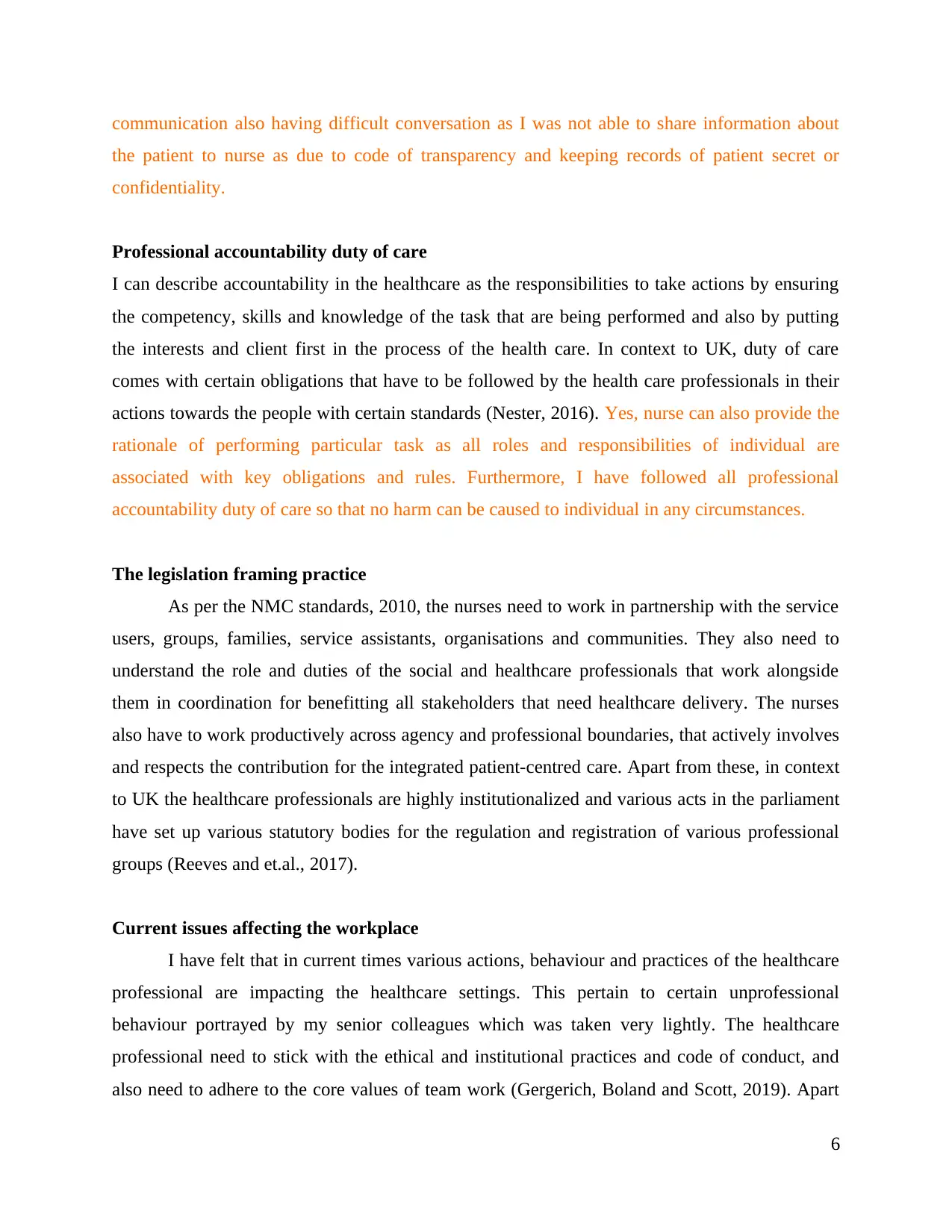
communication also having difficult conversation as I was not able to share information about
the patient to nurse as due to code of transparency and keeping records of patient secret or
confidentiality.
Professional accountability duty of care
I can describe accountability in the healthcare as the responsibilities to take actions by ensuring
the competency, skills and knowledge of the task that are being performed and also by putting
the interests and client first in the process of the health care. In context to UK, duty of care
comes with certain obligations that have to be followed by the health care professionals in their
actions towards the people with certain standards (Nester, 2016). Yes, nurse can also provide the
rationale of performing particular task as all roles and responsibilities of individual are
associated with key obligations and rules. Furthermore, I have followed all professional
accountability duty of care so that no harm can be caused to individual in any circumstances.
The legislation framing practice
As per the NMC standards, 2010, the nurses need to work in partnership with the service
users, groups, families, service assistants, organisations and communities. They also need to
understand the role and duties of the social and healthcare professionals that work alongside
them in coordination for benefitting all stakeholders that need healthcare delivery. The nurses
also have to work productively across agency and professional boundaries, that actively involves
and respects the contribution for the integrated patient-centred care. Apart from these, in context
to UK the healthcare professionals are highly institutionalized and various acts in the parliament
have set up various statutory bodies for the regulation and registration of various professional
groups (Reeves and et.al., 2017).
Current issues affecting the workplace
I have felt that in current times various actions, behaviour and practices of the healthcare
professional are impacting the healthcare settings. This pertain to certain unprofessional
behaviour portrayed by my senior colleagues which was taken very lightly. The healthcare
professional need to stick with the ethical and institutional practices and code of conduct, and
also need to adhere to the core values of team work (Gergerich, Boland and Scott, 2019). Apart
6
the patient to nurse as due to code of transparency and keeping records of patient secret or
confidentiality.
Professional accountability duty of care
I can describe accountability in the healthcare as the responsibilities to take actions by ensuring
the competency, skills and knowledge of the task that are being performed and also by putting
the interests and client first in the process of the health care. In context to UK, duty of care
comes with certain obligations that have to be followed by the health care professionals in their
actions towards the people with certain standards (Nester, 2016). Yes, nurse can also provide the
rationale of performing particular task as all roles and responsibilities of individual are
associated with key obligations and rules. Furthermore, I have followed all professional
accountability duty of care so that no harm can be caused to individual in any circumstances.
The legislation framing practice
As per the NMC standards, 2010, the nurses need to work in partnership with the service
users, groups, families, service assistants, organisations and communities. They also need to
understand the role and duties of the social and healthcare professionals that work alongside
them in coordination for benefitting all stakeholders that need healthcare delivery. The nurses
also have to work productively across agency and professional boundaries, that actively involves
and respects the contribution for the integrated patient-centred care. Apart from these, in context
to UK the healthcare professionals are highly institutionalized and various acts in the parliament
have set up various statutory bodies for the regulation and registration of various professional
groups (Reeves and et.al., 2017).
Current issues affecting the workplace
I have felt that in current times various actions, behaviour and practices of the healthcare
professional are impacting the healthcare settings. This pertain to certain unprofessional
behaviour portrayed by my senior colleagues which was taken very lightly. The healthcare
professional need to stick with the ethical and institutional practices and code of conduct, and
also need to adhere to the core values of team work (Gergerich, Boland and Scott, 2019). Apart
6
⊘ This is a preview!⊘
Do you want full access?
Subscribe today to unlock all pages.

Trusted by 1+ million students worldwide

from that there are various organisational barriers such as lack of knowledge and appreciation of
the other healthcare professionals’ financial aids, legal scope of the healthcare competency and
practice, and most significantly hierarchical administration and such structures that discourage
interprofessional teamwork. On the team level, the current issues and challenges I faced at the
workplace are a lack of clarity in the purpose and lack of training thus it means that I was not
cleared about roles and responsibilities that need to be performed. At the same time lack of
training program has created problem for me to understand the way task can be completed and
patient can be effectively treated. Thus, all such experienced are directly linked to my previous
experienced while working as health professional. There are also circumstances of ambiguity in
the leadership and team formations or size (Brewer and Barr, 2016). I also felt that the team is
not always composed of proper professionals and there is a sever lack of an established
mechanism in timely delivery of information. In my case the orientation that took place was not
appropriate as the nurse showed unethical behaviour, therefore I can say that there is a dire need
for professional yet effective onboarding for new team members. There are other barriers like a
weak framework for the discovery of issues and their resolution. The most significant issue is the
different in the level of power, authority and expertise. There are problems of team member
engagement and a lower commitment shown by the team members (Goldsberry, 2018) It has
impacted me as I was unable to coordinate diverse individual to work together as a team for
achievements of specific goals. There lack of commitment has created barrier for me in
completing my task in best possible manner. Therefore low engagement and lower commitment
has adversely affected me.
There are various things that can go wrong due to these barriers. These may involve the
disrespect of the privacy of a patient if the team doesn’t portray ethical code of conduct while
practicing healthcare processes. Thus it may negative impact patient as it crucial information are
disclosed to others. Apart from that, the issues of lack of training that I noticed in my
experience, can reduce the productivity of the people, the team efficiency in completing
complicated or multiple tasks with similar efficiency. Thus it affect the quality of healthcare
delivery and less services to customers. If the professional like the nurse in this case, do not
comply with the code of ethics and conduct, it may result in poor impression on the other team
members, inefficiency in work, dissatisfaction of the client. Also, the breaches of privacy done
by the nurse can account for serious healthcare ethical violation. Therefore it can be understand
7
the other healthcare professionals’ financial aids, legal scope of the healthcare competency and
practice, and most significantly hierarchical administration and such structures that discourage
interprofessional teamwork. On the team level, the current issues and challenges I faced at the
workplace are a lack of clarity in the purpose and lack of training thus it means that I was not
cleared about roles and responsibilities that need to be performed. At the same time lack of
training program has created problem for me to understand the way task can be completed and
patient can be effectively treated. Thus, all such experienced are directly linked to my previous
experienced while working as health professional. There are also circumstances of ambiguity in
the leadership and team formations or size (Brewer and Barr, 2016). I also felt that the team is
not always composed of proper professionals and there is a sever lack of an established
mechanism in timely delivery of information. In my case the orientation that took place was not
appropriate as the nurse showed unethical behaviour, therefore I can say that there is a dire need
for professional yet effective onboarding for new team members. There are other barriers like a
weak framework for the discovery of issues and their resolution. The most significant issue is the
different in the level of power, authority and expertise. There are problems of team member
engagement and a lower commitment shown by the team members (Goldsberry, 2018) It has
impacted me as I was unable to coordinate diverse individual to work together as a team for
achievements of specific goals. There lack of commitment has created barrier for me in
completing my task in best possible manner. Therefore low engagement and lower commitment
has adversely affected me.
There are various things that can go wrong due to these barriers. These may involve the
disrespect of the privacy of a patient if the team doesn’t portray ethical code of conduct while
practicing healthcare processes. Thus it may negative impact patient as it crucial information are
disclosed to others. Apart from that, the issues of lack of training that I noticed in my
experience, can reduce the productivity of the people, the team efficiency in completing
complicated or multiple tasks with similar efficiency. Thus it affect the quality of healthcare
delivery and less services to customers. If the professional like the nurse in this case, do not
comply with the code of ethics and conduct, it may result in poor impression on the other team
members, inefficiency in work, dissatisfaction of the client. Also, the breaches of privacy done
by the nurse can account for serious healthcare ethical violation. Therefore it can be understand
7
Paraphrase This Document
Need a fresh take? Get an instant paraphrase of this document with our AI Paraphraser
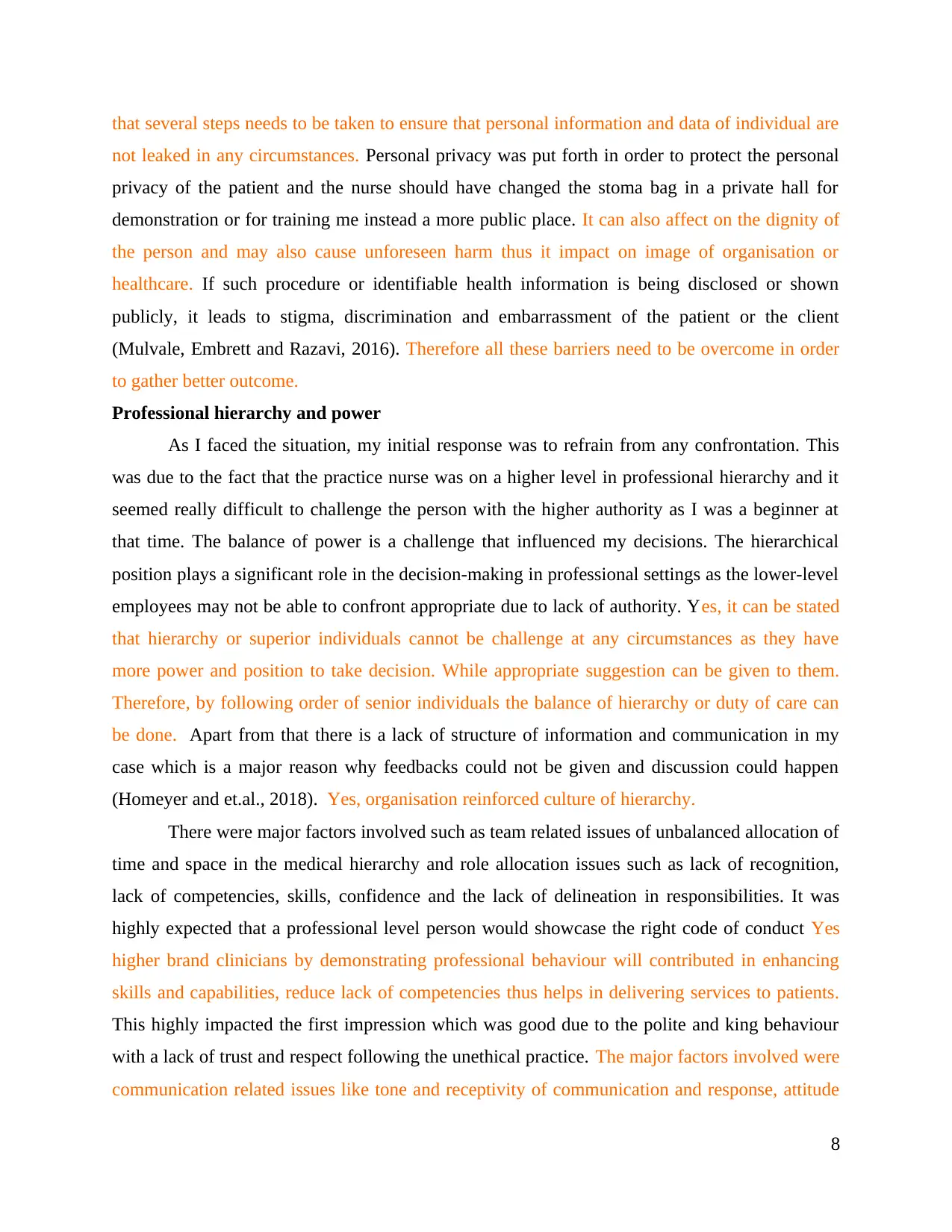
that several steps needs to be taken to ensure that personal information and data of individual are
not leaked in any circumstances. Personal privacy was put forth in order to protect the personal
privacy of the patient and the nurse should have changed the stoma bag in a private hall for
demonstration or for training me instead a more public place. It can also affect on the dignity of
the person and may also cause unforeseen harm thus it impact on image of organisation or
healthcare. If such procedure or identifiable health information is being disclosed or shown
publicly, it leads to stigma, discrimination and embarrassment of the patient or the client
(Mulvale, Embrett and Razavi, 2016). Therefore all these barriers need to be overcome in order
to gather better outcome.
Professional hierarchy and power
As I faced the situation, my initial response was to refrain from any confrontation. This
was due to the fact that the practice nurse was on a higher level in professional hierarchy and it
seemed really difficult to challenge the person with the higher authority as I was a beginner at
that time. The balance of power is a challenge that influenced my decisions. The hierarchical
position plays a significant role in the decision-making in professional settings as the lower-level
employees may not be able to confront appropriate due to lack of authority. Yes, it can be stated
that hierarchy or superior individuals cannot be challenge at any circumstances as they have
more power and position to take decision. While appropriate suggestion can be given to them.
Therefore, by following order of senior individuals the balance of hierarchy or duty of care can
be done. Apart from that there is a lack of structure of information and communication in my
case which is a major reason why feedbacks could not be given and discussion could happen
(Homeyer and et.al., 2018). Yes, organisation reinforced culture of hierarchy.
There were major factors involved such as team related issues of unbalanced allocation of
time and space in the medical hierarchy and role allocation issues such as lack of recognition,
lack of competencies, skills, confidence and the lack of delineation in responsibilities. It was
highly expected that a professional level person would showcase the right code of conduct Yes
higher brand clinicians by demonstrating professional behaviour will contributed in enhancing
skills and capabilities, reduce lack of competencies thus helps in delivering services to patients.
This highly impacted the first impression which was good due to the polite and king behaviour
with a lack of trust and respect following the unethical practice. The major factors involved were
communication related issues like tone and receptivity of communication and response, attitude
8
not leaked in any circumstances. Personal privacy was put forth in order to protect the personal
privacy of the patient and the nurse should have changed the stoma bag in a private hall for
demonstration or for training me instead a more public place. It can also affect on the dignity of
the person and may also cause unforeseen harm thus it impact on image of organisation or
healthcare. If such procedure or identifiable health information is being disclosed or shown
publicly, it leads to stigma, discrimination and embarrassment of the patient or the client
(Mulvale, Embrett and Razavi, 2016). Therefore all these barriers need to be overcome in order
to gather better outcome.
Professional hierarchy and power
As I faced the situation, my initial response was to refrain from any confrontation. This
was due to the fact that the practice nurse was on a higher level in professional hierarchy and it
seemed really difficult to challenge the person with the higher authority as I was a beginner at
that time. The balance of power is a challenge that influenced my decisions. The hierarchical
position plays a significant role in the decision-making in professional settings as the lower-level
employees may not be able to confront appropriate due to lack of authority. Yes, it can be stated
that hierarchy or superior individuals cannot be challenge at any circumstances as they have
more power and position to take decision. While appropriate suggestion can be given to them.
Therefore, by following order of senior individuals the balance of hierarchy or duty of care can
be done. Apart from that there is a lack of structure of information and communication in my
case which is a major reason why feedbacks could not be given and discussion could happen
(Homeyer and et.al., 2018). Yes, organisation reinforced culture of hierarchy.
There were major factors involved such as team related issues of unbalanced allocation of
time and space in the medical hierarchy and role allocation issues such as lack of recognition,
lack of competencies, skills, confidence and the lack of delineation in responsibilities. It was
highly expected that a professional level person would showcase the right code of conduct Yes
higher brand clinicians by demonstrating professional behaviour will contributed in enhancing
skills and capabilities, reduce lack of competencies thus helps in delivering services to patients.
This highly impacted the first impression which was good due to the polite and king behaviour
with a lack of trust and respect following the unethical practice. The major factors involved were
communication related issues like tone and receptivity of communication and response, attitude
8
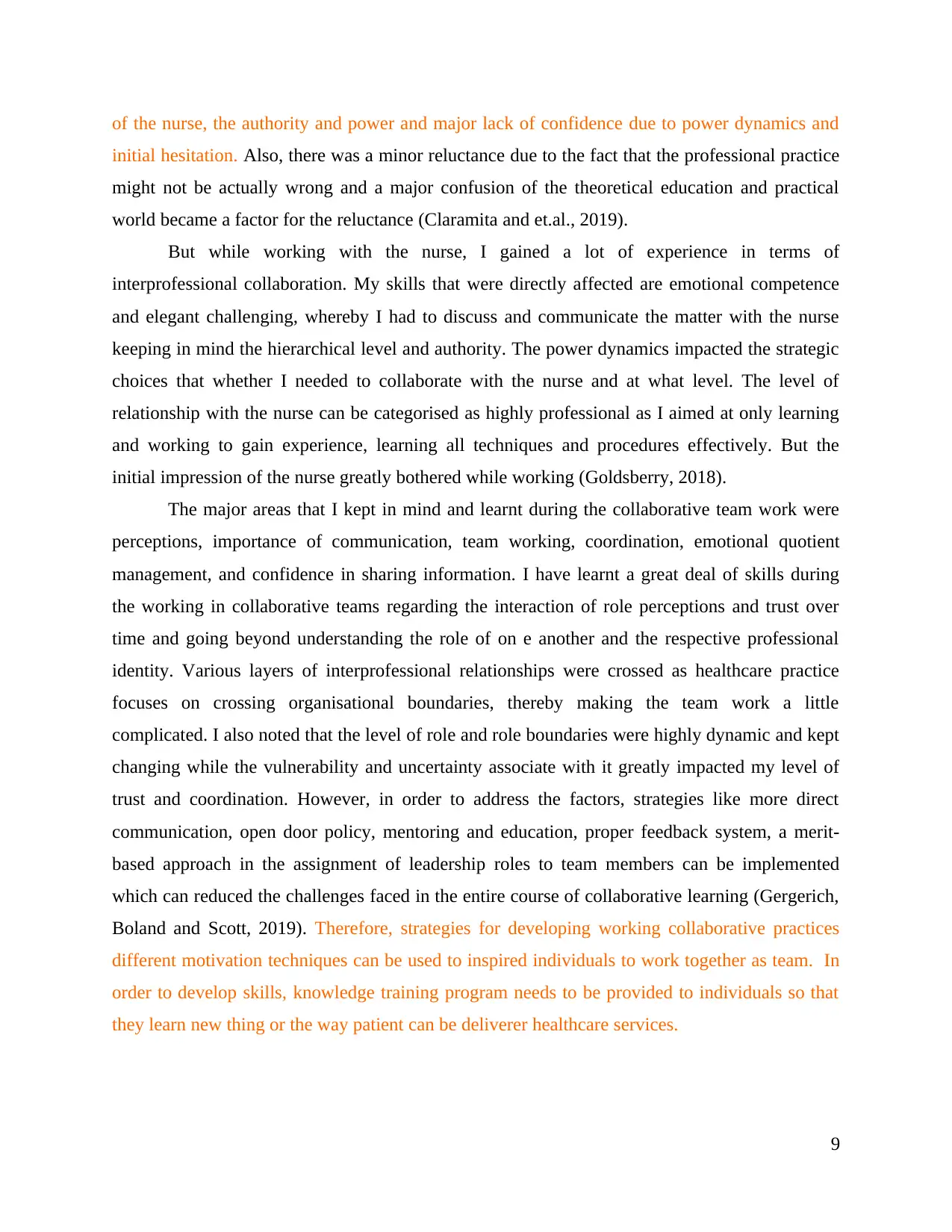
of the nurse, the authority and power and major lack of confidence due to power dynamics and
initial hesitation. Also, there was a minor reluctance due to the fact that the professional practice
might not be actually wrong and a major confusion of the theoretical education and practical
world became a factor for the reluctance (Claramita and et.al., 2019).
But while working with the nurse, I gained a lot of experience in terms of
interprofessional collaboration. My skills that were directly affected are emotional competence
and elegant challenging, whereby I had to discuss and communicate the matter with the nurse
keeping in mind the hierarchical level and authority. The power dynamics impacted the strategic
choices that whether I needed to collaborate with the nurse and at what level. The level of
relationship with the nurse can be categorised as highly professional as I aimed at only learning
and working to gain experience, learning all techniques and procedures effectively. But the
initial impression of the nurse greatly bothered while working (Goldsberry, 2018).
The major areas that I kept in mind and learnt during the collaborative team work were
perceptions, importance of communication, team working, coordination, emotional quotient
management, and confidence in sharing information. I have learnt a great deal of skills during
the working in collaborative teams regarding the interaction of role perceptions and trust over
time and going beyond understanding the role of on e another and the respective professional
identity. Various layers of interprofessional relationships were crossed as healthcare practice
focuses on crossing organisational boundaries, thereby making the team work a little
complicated. I also noted that the level of role and role boundaries were highly dynamic and kept
changing while the vulnerability and uncertainty associate with it greatly impacted my level of
trust and coordination. However, in order to address the factors, strategies like more direct
communication, open door policy, mentoring and education, proper feedback system, a merit-
based approach in the assignment of leadership roles to team members can be implemented
which can reduced the challenges faced in the entire course of collaborative learning (Gergerich,
Boland and Scott, 2019). Therefore, strategies for developing working collaborative practices
different motivation techniques can be used to inspired individuals to work together as team. In
order to develop skills, knowledge training program needs to be provided to individuals so that
they learn new thing or the way patient can be deliverer healthcare services.
9
initial hesitation. Also, there was a minor reluctance due to the fact that the professional practice
might not be actually wrong and a major confusion of the theoretical education and practical
world became a factor for the reluctance (Claramita and et.al., 2019).
But while working with the nurse, I gained a lot of experience in terms of
interprofessional collaboration. My skills that were directly affected are emotional competence
and elegant challenging, whereby I had to discuss and communicate the matter with the nurse
keeping in mind the hierarchical level and authority. The power dynamics impacted the strategic
choices that whether I needed to collaborate with the nurse and at what level. The level of
relationship with the nurse can be categorised as highly professional as I aimed at only learning
and working to gain experience, learning all techniques and procedures effectively. But the
initial impression of the nurse greatly bothered while working (Goldsberry, 2018).
The major areas that I kept in mind and learnt during the collaborative team work were
perceptions, importance of communication, team working, coordination, emotional quotient
management, and confidence in sharing information. I have learnt a great deal of skills during
the working in collaborative teams regarding the interaction of role perceptions and trust over
time and going beyond understanding the role of on e another and the respective professional
identity. Various layers of interprofessional relationships were crossed as healthcare practice
focuses on crossing organisational boundaries, thereby making the team work a little
complicated. I also noted that the level of role and role boundaries were highly dynamic and kept
changing while the vulnerability and uncertainty associate with it greatly impacted my level of
trust and coordination. However, in order to address the factors, strategies like more direct
communication, open door policy, mentoring and education, proper feedback system, a merit-
based approach in the assignment of leadership roles to team members can be implemented
which can reduced the challenges faced in the entire course of collaborative learning (Gergerich,
Boland and Scott, 2019). Therefore, strategies for developing working collaborative practices
different motivation techniques can be used to inspired individuals to work together as team. In
order to develop skills, knowledge training program needs to be provided to individuals so that
they learn new thing or the way patient can be deliverer healthcare services.
9
⊘ This is a preview!⊘
Do you want full access?
Subscribe today to unlock all pages.

Trusted by 1+ million students worldwide
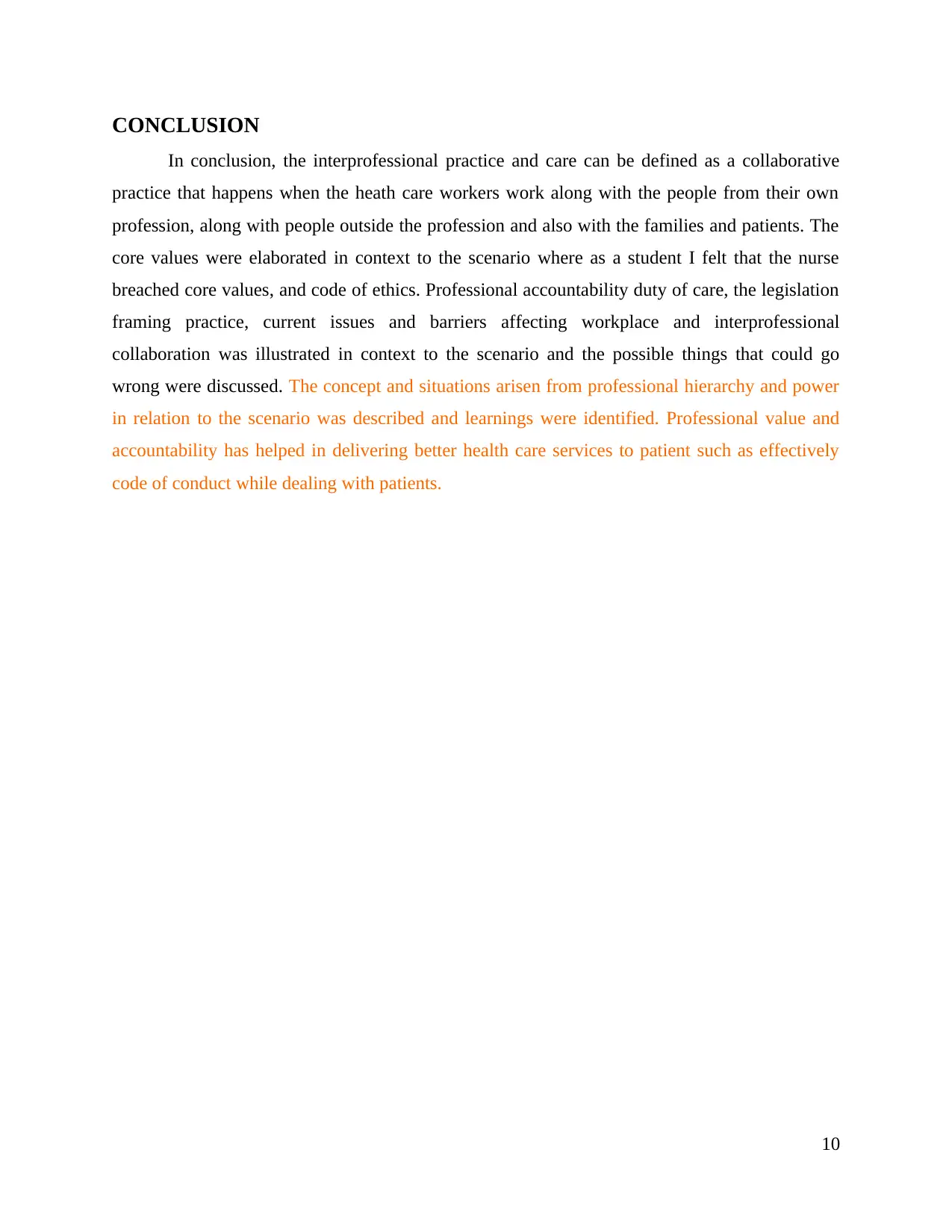
CONCLUSION
In conclusion, the interprofessional practice and care can be defined as a collaborative
practice that happens when the heath care workers work along with the people from their own
profession, along with people outside the profession and also with the families and patients. The
core values were elaborated in context to the scenario where as a student I felt that the nurse
breached core values, and code of ethics. Professional accountability duty of care, the legislation
framing practice, current issues and barriers affecting workplace and interprofessional
collaboration was illustrated in context to the scenario and the possible things that could go
wrong were discussed. The concept and situations arisen from professional hierarchy and power
in relation to the scenario was described and learnings were identified. Professional value and
accountability has helped in delivering better health care services to patient such as effectively
code of conduct while dealing with patients.
10
In conclusion, the interprofessional practice and care can be defined as a collaborative
practice that happens when the heath care workers work along with the people from their own
profession, along with people outside the profession and also with the families and patients. The
core values were elaborated in context to the scenario where as a student I felt that the nurse
breached core values, and code of ethics. Professional accountability duty of care, the legislation
framing practice, current issues and barriers affecting workplace and interprofessional
collaboration was illustrated in context to the scenario and the possible things that could go
wrong were discussed. The concept and situations arisen from professional hierarchy and power
in relation to the scenario was described and learnings were identified. Professional value and
accountability has helped in delivering better health care services to patient such as effectively
code of conduct while dealing with patients.
10
Paraphrase This Document
Need a fresh take? Get an instant paraphrase of this document with our AI Paraphraser
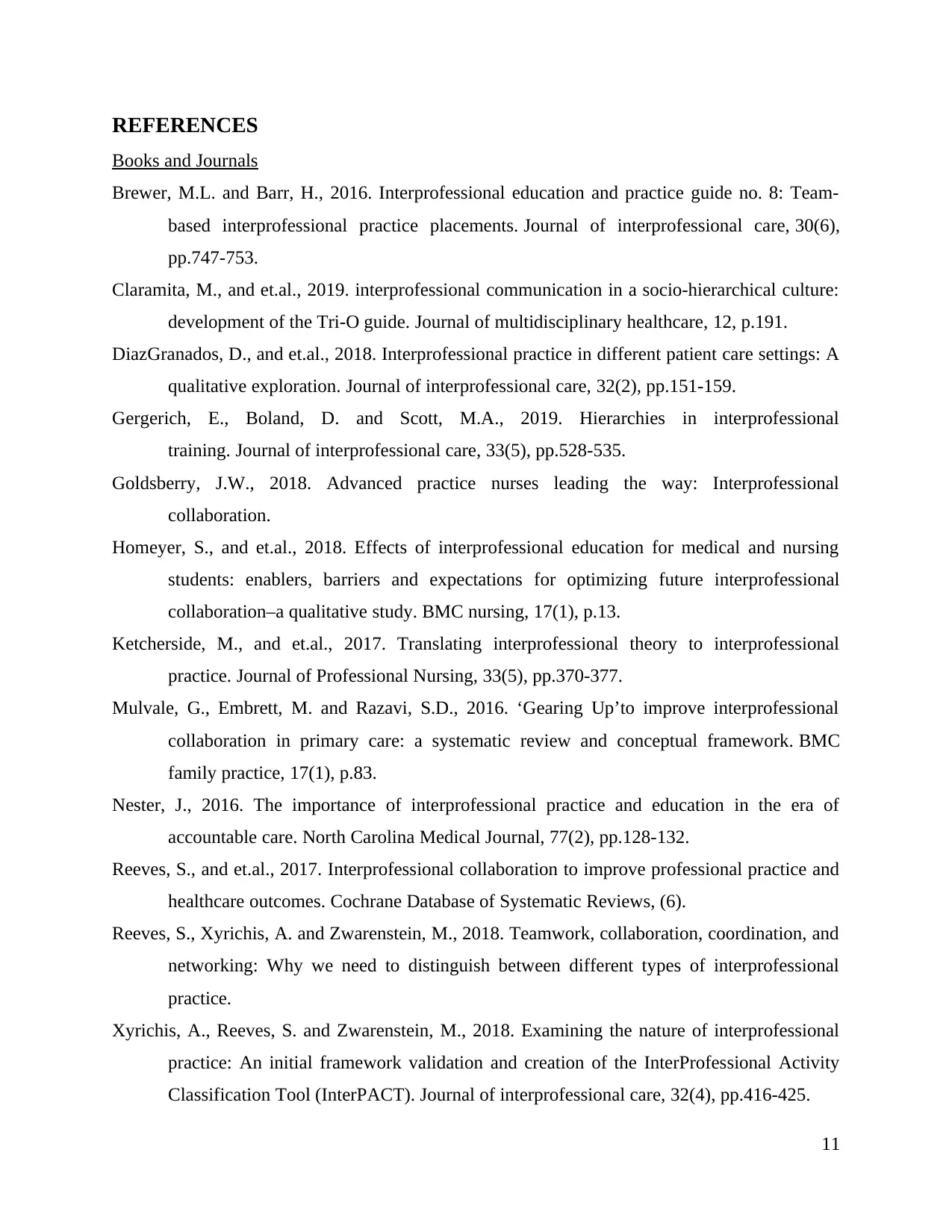
REFERENCES
Books and Journals
Brewer, M.L. and Barr, H., 2016. Interprofessional education and practice guide no. 8: Team-
based interprofessional practice placements. Journal of interprofessional care, 30(6),
pp.747-753.
Claramita, M., and et.al., 2019. interprofessional communication in a socio-hierarchical culture:
development of the Tri-O guide. Journal of multidisciplinary healthcare, 12, p.191.
DiazGranados, D., and et.al., 2018. Interprofessional practice in different patient care settings: A
qualitative exploration. Journal of interprofessional care, 32(2), pp.151-159.
Gergerich, E., Boland, D. and Scott, M.A., 2019. Hierarchies in interprofessional
training. Journal of interprofessional care, 33(5), pp.528-535.
Goldsberry, J.W., 2018. Advanced practice nurses leading the way: Interprofessional
collaboration.
Homeyer, S., and et.al., 2018. Effects of interprofessional education for medical and nursing
students: enablers, barriers and expectations for optimizing future interprofessional
collaboration–a qualitative study. BMC nursing, 17(1), p.13.
Ketcherside, M., and et.al., 2017. Translating interprofessional theory to interprofessional
practice. Journal of Professional Nursing, 33(5), pp.370-377.
Mulvale, G., Embrett, M. and Razavi, S.D., 2016. ‘Gearing Up’to improve interprofessional
collaboration in primary care: a systematic review and conceptual framework. BMC
family practice, 17(1), p.83.
Nester, J., 2016. The importance of interprofessional practice and education in the era of
accountable care. North Carolina Medical Journal, 77(2), pp.128-132.
Reeves, S., and et.al., 2017. Interprofessional collaboration to improve professional practice and
healthcare outcomes. Cochrane Database of Systematic Reviews, (6).
Reeves, S., Xyrichis, A. and Zwarenstein, M., 2018. Teamwork, collaboration, coordination, and
networking: Why we need to distinguish between different types of interprofessional
practice.
Xyrichis, A., Reeves, S. and Zwarenstein, M., 2018. Examining the nature of interprofessional
practice: An initial framework validation and creation of the InterProfessional Activity
Classification Tool (InterPACT). Journal of interprofessional care, 32(4), pp.416-425.
11
Books and Journals
Brewer, M.L. and Barr, H., 2016. Interprofessional education and practice guide no. 8: Team-
based interprofessional practice placements. Journal of interprofessional care, 30(6),
pp.747-753.
Claramita, M., and et.al., 2019. interprofessional communication in a socio-hierarchical culture:
development of the Tri-O guide. Journal of multidisciplinary healthcare, 12, p.191.
DiazGranados, D., and et.al., 2018. Interprofessional practice in different patient care settings: A
qualitative exploration. Journal of interprofessional care, 32(2), pp.151-159.
Gergerich, E., Boland, D. and Scott, M.A., 2019. Hierarchies in interprofessional
training. Journal of interprofessional care, 33(5), pp.528-535.
Goldsberry, J.W., 2018. Advanced practice nurses leading the way: Interprofessional
collaboration.
Homeyer, S., and et.al., 2018. Effects of interprofessional education for medical and nursing
students: enablers, barriers and expectations for optimizing future interprofessional
collaboration–a qualitative study. BMC nursing, 17(1), p.13.
Ketcherside, M., and et.al., 2017. Translating interprofessional theory to interprofessional
practice. Journal of Professional Nursing, 33(5), pp.370-377.
Mulvale, G., Embrett, M. and Razavi, S.D., 2016. ‘Gearing Up’to improve interprofessional
collaboration in primary care: a systematic review and conceptual framework. BMC
family practice, 17(1), p.83.
Nester, J., 2016. The importance of interprofessional practice and education in the era of
accountable care. North Carolina Medical Journal, 77(2), pp.128-132.
Reeves, S., and et.al., 2017. Interprofessional collaboration to improve professional practice and
healthcare outcomes. Cochrane Database of Systematic Reviews, (6).
Reeves, S., Xyrichis, A. and Zwarenstein, M., 2018. Teamwork, collaboration, coordination, and
networking: Why we need to distinguish between different types of interprofessional
practice.
Xyrichis, A., Reeves, S. and Zwarenstein, M., 2018. Examining the nature of interprofessional
practice: An initial framework validation and creation of the InterProfessional Activity
Classification Tool (InterPACT). Journal of interprofessional care, 32(4), pp.416-425.
11
1 out of 11
Related Documents
Your All-in-One AI-Powered Toolkit for Academic Success.
+13062052269
info@desklib.com
Available 24*7 on WhatsApp / Email
![[object Object]](/_next/static/media/star-bottom.7253800d.svg)
Unlock your academic potential
Copyright © 2020–2025 A2Z Services. All Rights Reserved. Developed and managed by ZUCOL.





